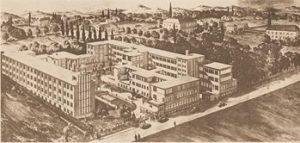Hungarian Optical Works
Budapest, Alkotás Street 9.
Budapest, Csörsz Street 39.
The production of precision fine-mechanical instruments with the highest possible technical standards, as well as the training of the workforce necessary for this. According to the founder, education should be given as much emphasis as production itself, and this view has played a decisive role in the life of the company throughout. MOM's most characteristic products were Geodetic instruments, in this area they achieved the most success.
- Nandor Suss, 1876-1919
- Konstantin Smirnov, 1949-1952
- Gyula Posch, 1956 – 1983
- Béla Bátor, mechanical design of the first Heller–Forgó cooling element, water loss-free cooling of power plants
- Péter Závodszky, biophysicist, design of thermostable proteins
- József Kmetty, CEO of Kürt Rt.
- László Bezzegh, world patent holder of the MOM Ta-D1 pie chart tachymeter
- Ferenc Pusztai, the development of the gyrotheodolite. MOM gyrotheodolites were used in the construction of the Budapest, Warsaw, and Prague metros and in the construction of the LHC (Large Hadron Collider) near CERN Geneva.
The development of geodetic instruments brought international recognition. In 1958, three instruments, the Te-D1 type theodolite, the Ni-B1 type leveling device and the Ma-1 measuring table equipment, won the Grand Prize of the Brussels World Exhibition. Among the designers of the instruments, Károly Bors received the Kossuth Prize in 1958, and László Bezzegh and Ferenc Schinagl in 1960. By 1963, the gyro theodolite was ready, with the help of which the direction of the Earth's axis of rotation can be determined in the field. Ferenc Pusztai also received the Kossuth Prize in 1963 for the development of the instrument.
Its outstanding products: short film camera, Te-823 second theodolite (Károly Bors), Ni-A31 automatic level (Pál Tóth), Gi-B2 gyro theodolite, which won the Grand Prix at the Brussels World Fair in 1958 (Ferenc Pusztai), circular tachymeter (László Bezzegh), microwave rangefinder, SPEKTROMOM laboratory spectrophotometer family in the ultraviolet-visible-infrared wavelength range (András Balog), Derivatograph thermogravimetric material testing equipment (Ferenc Paulik-Jenő Paulik), 60,000 rpm laboratory ultracentrifuge (Ferenc Rohonci), MOMCOLOR colorimeter family (Gyula Lukács), fiber optics production and fiber optic systems (Antal Lisziewicz, Géza Hegyessy, Dezső Besskó, State Award recipients), He-Ne direction-setting laser, tape and edge-perforated card punch, card reader, magnetic disk storage.
In addition to all this, they also dealt with the production of military (optical) and medical laboratory instruments, and even vehicle parts (oil brakes, locomotive armature).
1876 – University of Cluj-Napoca Mechanical Station (instrument manufacturing, mechanic training)
1884 – Mechanical Training Workshop (State-aided), Bp. Mozsár u. 8. From 1891 Bp. Alkotás u. 9.
1900 – Nándor Süss Precision Mechanics Institute, Bp. Alkotás u. 9. From 1905 Bp. Csörsz u. 39.
1918 – Nándor Süss Precision Mechanical Institute Limited Liability Company
1922 – Nándor Süss Precision Mechanics and Optics Institute Ltd.
1939 – Hungarian Optical Works Co. Ltd.
1952 – Hungarian Optical Works
1998 – Hungarian Optical Works ceases to exist without a legal successor.
Instruments developed by Loránd Eötvös, including the Eötvös pendulum, were made in Nándor Süss's precision mechanics workshop.
MOM supplied the British with 250,000 anti-aircraft watch igniters under a deal concluded in 1937. This originally German invention was used to destroy the planes of the Third Reich in the Battle of Britain.
- Hungarian Optical Works iTF event, September 25, 2013.
- A brief history and current situation of some Hungarian electronics companies
- MOM and computer science September 25, 2013. Lecture by Károly Molnár
- MOM and computer science September 25, 2013. Lecture by Ferenc Meichl
- MOM and computing
- MOM and computing
- Chapters from the history of the Hungarian Optical Works and its successors 1876-2015
Created: 2016.07.16. 13:35
Last modified: 2024.02.27. 19:10

